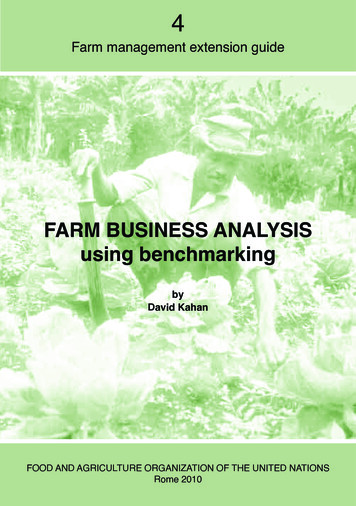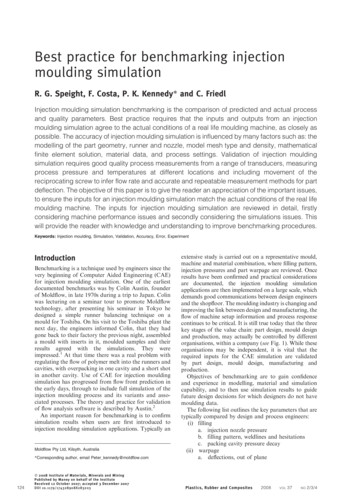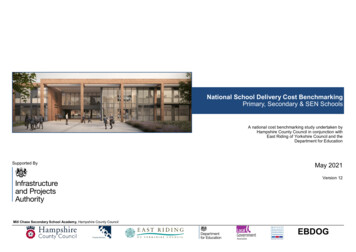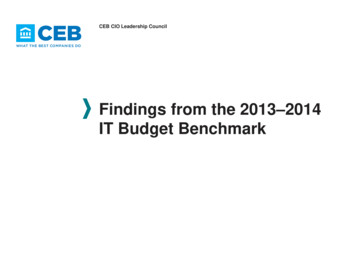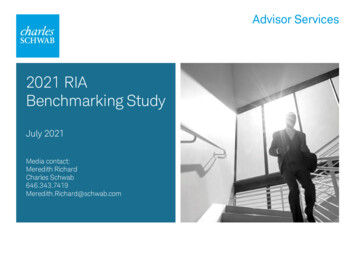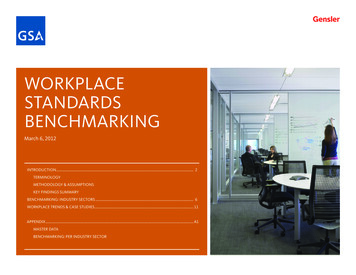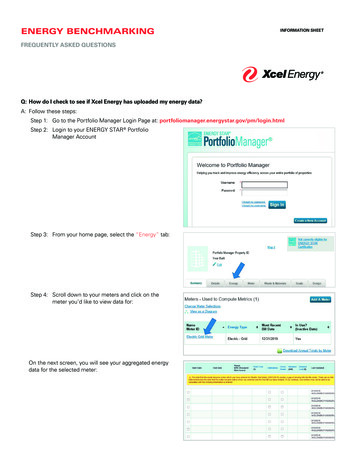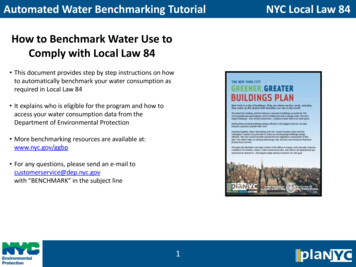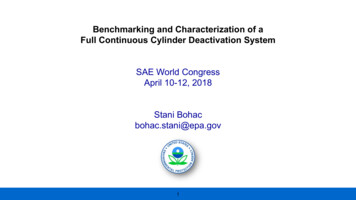
Transcription
Benchmarking and Characterization of aFull Continuous Cylinder Deactivation SystemSAE World CongressApril 10-12, 2018Stani Bohacbohac.stani@epa.gov1
Benefits and Challenges of Cylinder DeactivationCDA has the potential to improve engine efficiency at relatively low cost. Reduced pumping Reduced cylinder heat transfer Improved throttle responseChallenges: Transitions NVH Durable deactivation system Benefit limited to low engine load2
Types of Cylinder DeactivationEPA considering two types of CDA:deacPD partial discrete (e.g., 8 or 4 cylinders)deacFC full continuous (e.g., continuous between 0-8 cylinders)3
Why is EPA Interested?EPA continuously evaluates advanced technologies to support the setting of appropriate GHG standards. Light-duty GHG standards through 2025 are being reconsidered and revised.EPA’s prior analysis1 considered deacPD but not deacFC.DeacFC is a potential enabler for meeting GHG standards2.This investigation was conducted to benchmark and characterize deacFC and evaluate its potential as anadvanced, production-ready technology for reducing GHG emissions.1)2)4EPA, 2017, EPA-420-R-17-001Younkins et al., 2017, 38th International Vienna Motor Symposium
ObjectivesCharacterize effectiveness and fly zone of deacFC Steady-state tests EPA chassis benchmarking – V8effectiveness curvesfor I3, I4, V6, V8 Tula engine publications – V8, I4 Drive cycle tests EPA benchmarking – V8deacFC fly zone Tula publications – V8Compare drive cycleefficiencies fromsimulation and labInitial full vehicle modeling using ALPHACompare deacFC benefiton two vehicle types5
deacFC VehiclesTula Technology Dynamic Skip Fire (DSF) applied to2011 GMC Yukon Denali 6.2L L94 fires 0-8 cylinders EPA and TulaPhoto by TulaTula Technology DSF applied to2015 VW Jetta 1.8L EA888Photo by Tula6 fires 0-4 cylinders Tula
Steady-State Operation7
deacFC benefit on V8 (EPA benchmarking)Test vehicle provided by Tula TechnologyMY2011 GMC Yukon Denali 2WD6.2L L94 V8 PFI gasoline engine6L80 6-speed automatic transmissionTier 2, 93 AKI test fuel“V8 mode” GM ECU, disabled AFM Torque converter slip: 17-39 rpm“deacFC mode” Tula ECU, deacFC Torque converter slip: 28-85 rpm8
Steady-State Chassis Tests (EPA benchmarking)Vehicle 49 and 81 mphEngine deacFC and V8 mode 1200 – 2600 rpm 0.3 – 5.8 bar BMEP (add variable gradient load to SET road load)Torque Converter 17 – 85 rpm slipTransmission 5th and 6th gearComponentLossSourceElectrical load0.42 kWbenchmarkingTorque converter0.03 – 2.17 kWengine speed and torque, chassis roll speedTransmission1.31 – 3.82 kW2014 GM 6L80 benchmarking3Differential0.38 – 2.65 kW1999 Ford 3.55 differential/axle benchmarking4Drive tires2.35 – 3.90 kWCrr 0.0095, test weight 6000 lbs, wt dist. 55/453) Stuhldreher et al., SAE 2017-01-50204) EPA and SwRI, 1999, Contract No. 68-C7-00125) NAS, 2006, Tires and Passenger Vehicle Fuel Economy9
deacFC benefit on V8 (EPA benchmarking)6055curve fit from 0-6 bary 0.03687x4 - 0.8740x3 7.613x2 - 30.03x 49.0245chassis dynamometer testingMY2011 Yukon DenaliGM 6.2L L94 V8 PFI engineTier 2, 93 AKI test fuel4035chassis dyno, 1200 rpmchassis dyno, 2000 rpm302520chassis dyno, 2300 rpm151050-1012345678910BMEP (bar)6055V850Reduction in BSFC (%)Reduction in BSFC (%)5045V64035ALPHA full vehicle model(EPA effectiveness)I4I3302520151050-1012345BMEP (bar)10678910
deacFC benefit on V8 (Tula publication)engine dynamometer testing2GM 6.2L L94 V8 PFI engine1600 rpm93 AKI fuelV8 no cylinder deactivationDSF Dynamic Skip Fire(Tula deacFC)60curve fit to 0 bary 0.007750x4 - 0.3082x3 4.400x2 - 26.73x 58.225550Reduction in BSFC (%)* GHG standards call for Tier 2 test fuel* deacFC benefit would be lower with lower AKI45V8 engine dyno data4035 Extrapolating benefit to -2 bar adds less than0.1% benefit in FTP-75 (simulation result)because engine doesn’t spend time here.302520151050-10123456789BMEP (bar)102) Younkins et al., 2017, 38th International Vienna Motor Symposium11
deacFC benefit on I4 turbo (Tula publication)engine dynamometer testing6VW 1.8L EA888 I4 turbo engine1600 rpm87 AKI CARB fuel GHG standards call for Tier 2 test fuelUse of 87 AKI gives a lower (conservative) deacFC benefit6055Reduction in BSFC (%)5045curve vit to 0 bary 0.004788x4 - 0.07890x3 1.280x2 - 12.22x 38.1540353025I4 turbo engine dyno data20151050-1012345678910BMEP (bar)6) Fuschetto et al., 2017, Oral-Only Presentation, SAE World Congress12
deacFC benefit scaled to V8, V6, I4, I3 (Tula publication)V86055Reduction in BSFC (%)50potentially due to cylinder count45I44035302520ALPHA full vehicle model(Tula effectiveness)151087 AKI593 AKI0-1012345678910BMEP (bar)V86055V6Assume benefit at 0 bar scales with cylinder number (NVH)I3, I4, V6 curves for 87 AKI tests (conservative) since GHGstandards specify 93 AKIReduction in BSFC (%)5045I4I34035302520151050-1012345BMEP (bar)13678910
Comparing EPA Chassis and Tula Engine deacFC 12345678910BMEP (bar)V86055Reduction in BSFC (%)Tula Engine TestsV650Reduction in BSFC (%)Reduction in BSFC (%)EPA Chassis TestsV85045deacFC benefit on V8 fromTula engine measurements40353025deacFC benefit on V8 fromEPA chassis measurements2015105450I4I34035-10123456789BMEP (bar)3025 EPA and Tula effectiveness curves arevery similar.20151050-1012345678910BMEP (bar)1410
Drive Cycle Operation15
deacFC benefit on V8 (Tula publication2)Chassis dynamometer testingMY2011 GMC Yukon Denali 2WD6.2L L94 V8 PFI gasoline engine6L80 6-speed automatic transmissionTier 2, 93 AKI test fuelPhoto by Tula“V8 mode” GM ECU, disabled AFM and DFSO GM transmission shift strategy“deacFC mode” Tula ECU, deacFC and DFSO Slightly higher torque converter slip2) Younkins et al., 2017, 38th International Vienna Motor Symposium16
deacFC benefit on V8 (Tula publication2)FTP-75HWFETUS062) Younkins et al., 2017, 38th International Vienna Motor Symposium17
deacFC benchmarking at EPADrive cycle benchmarking performed to:1) Compare EPA and Tula results2) Quantify deacFC ‘fly zone’ needed forvehicle modelingTest vehicle:MY2011 GMC Yukon Denali 2WD6.2L L94 V8 PFI gasoline engine6L80 6-speed automatic transmissionTier 2, 93 AKI test fuel“V8 mode” GM ECU, disabled AFM and DFSO GM transmission shift strategy Passed Tier 2 bin 5 NMOG, CO, NOx, PM“deacFC mode” Tula ECU, deacFC and DFSO Slightly higher torque converter slip Passed Tier 2 bin 5 CO, NOx, PM18
deacFC benefit on V8Tula publication2EPA benchmarking*FTP-7517.0 %13.4 % (14.6 16.5 mpg)HWFET9.0 %9.9 % (25.0 27.5 mpg)US066.1 %9.5 % (14.4 15.7 mpg)EPA benchmarking shows: Smaller deacFC benefit in FTP-75, higher deacFC benefit in HWFET and US06 Average of 3 cycles almost identical (10.9% versus 10.7% improvement)Why the difference? different driver, different lab, different day deacFC benefit is the ratio of 2 tests (MPGdeacFC/MPGV8); error stackingNote DFSO is active in deacFC mode but not in V8 mode Full vehicle modeling7 shows DSFO provides 2.5% benefit in FTP-75 and 1.2% inHWFET in V8 mode.2) Younkins et al., 2017, 38th International Vienna Motor Symposium7) ALPHA model introduced by Lee et al., SAE 2013-01-0808* Average of 2 tests in V8 mode / average of 2 tests in V8 mode19
deacFC benefit on V8 – FTP-75 by Bag (EPA benchmarking)deacFC relative to V8Comment(% improvement in MPG)Bag 17.1 %deacFC inactive until oil warmsBag 215.8 %Lowest engine loadsBag 314.0 %Higher loads than bag 220
deacFC benefit on V8 – FTP-75 by Mode (EPA Benchmarking)Bag 18070deacFCFE (mpg)6050110 s4080207010deacFCV860061116212631FE (mpg)1Mode Number of FTP-75 (Bag 1)Bag 3805040302070deacFC10V860FE (mpg)Bag 23003250374247525762677277Mode Number of FTP-75 (Bag 2)40302010082879297102107112Mode Number of FTP-75 (Bag 3)21 deacFC becomes active after 110 s. deacFC advantage only present whenFE is high (low engine load).
deacFC Fly Zone on V8 (EPA benchmarking)Used FTP-75, HWFET, US06 tests and MAP to quantify V8 deacFC fly zone.Activate deacFC if all conditions are true:1) Tcoolant 47.3 C2) Engine speed 940 rpmALPHA full vehicle model3) Gear 2-622
Full Vehicle Modeling23
ALPHA Full Vehicle Model of V8 YukonALPHA full vehicle model7Vehicle characteristicsTest weight 6000 lbsRoad load coefficients: A 32.15 lb, B 1.0382 lb/mph, C 0.02111 lb/mph2EngineGM 4.3L LV3 engine8 scaled to GM 6.2L L94 considering9:Heat transferFrictionKnock propensityEngine inertia 0.33 kg/m2 (scaled based on displacement)deacFC effectiveness curve froma) EPA chassis testsb) Tula engine testsdeacFC fly zone from EPA chassis testsDFSOallowed in deacFC modenot allowed in V8 modeMin BSFC as a function of powerTorque converterLockedSemi-locked26 rpm slip in V8 mode55 rpm slip in deacFCUnlockedTransmission2014 GM 6L80 benchmarking3Min. downshift speed 540 rpmMin. upshift speed 1200 rpmDifferential3.42 ratio1999 Ford 3.55 differential/axle benchmarking4Tier 2 Fuel:3) Stuhldreher et al., SAE 2017-01-50204) EPA and SwRI, 1999, Contract No. 68-C7-00127) Lee et al., SAE 2013-01-08088) Stuhldreher, SAE 2016-01-06229) Dekraker et al., SAE 2017-01-0899ρ 0.74277 g/cm3@60FH/C 1.836 molar ratioLHV 42.898 MJ/kg24
Chassis Tests and Full Vehicle Model – V8 YukonEPA chassis dynoALPHA modelEPA chassis dyno effectivenessFTP-7514.6 16.5 mpg13%14.7 16.5 mpg13%HWFET25.0 27.5 mpg10 %24.9 27.5 mpg11 % deacFC mode (with DFSO) compared to V8 mode (no DFSO) DFSO provides 2.5% benefit in FTP-75 and 1.2% in HWFET in V8 modeTula chassis dyno2ALPHA modelTula engine dyno effectivenessFTP-7517%18%HWFET9%16% deacFC mode (with DFSO) compared to V8 mode (no DFSO) DFSO provides 2.5% benefit in FTP-75 and 1.2% in HWFET in V8 mode2) Younkins et al., 2017, 38th International Vienna Motor Symposium25
Combined Cycle Simulation Results2011 Large SUV and 2025 Midsize CarVehicleDescriptionCO2 Reduction (g/mi)Only Adding deacFCCombined Cycle2011 Large SUVVehicle: 2011 GM Yukon DenaliEngine:2014 GM 4.3L LV3 scaled to 6.2L9DFSOno stop/startno AFM2011 GM Yukon accessoriesdeacFC effectiveness from EPA chassis testsTransmission: 6-speed GM 6L808.8%Photo by Tula2025 Midsize CarVehicle: typical 2016 midsize car10 with:7.5% curb weight reduction10% aerodynamic improvement10% coefficient of rolling resistance reductionEngine:2016 Honda 1.5L L15B7 scaled to 1.42L9,10DFSOstop/startno CDAhigh efficiency accessories11deacFC effectiveness from EPA chassis tests, scaled to I4Transmission: future 8-speed11The Jetsons262.6%9) Dekraker et al., SAE 2017-01-089910) Stuhldreher et al., SAE 2018-01-031911) EPA, 2016, EPA-420-R-16-021
Summary and ConclusionsCharacterized deacFC effectiveness and fly zone Demonstration vehicle that met NVH and emissions constraints Benefit curves for I3, I4, V6, V8 Fly zoneConducted preliminary full vehicle modeling deacFC-equipped 6.2L Yukon Compared drive cycle efficiencies from chassis tests and full vehicle model Compared combined cycle CO2 reduction for 2011 large SUV and 2025 midsize carBased on this investigation, EPA considers deacFC to be a promising production-ready technologyfor reducing GHG emissions.27
AcknowledgementsTula TechnologyMatthew Younkins and Sam Hashemi for providing Tula Yukon Denali test vehicle.EPA NVFELScott Ludlam, Paul Burbage, Michael Matthews, Garrett Brown for chassis testing.EPA NCATKevin Newman, Paul Dekraker, Dan Barba for ALPHA modeling and guidance.28
Compare drive cycle efficiencies from simulation and lab Compare deacFCbenefit on two vehicle types. . Tula Technology DSF applied to 2015 VW Jetta 1.8L EA888 fires 0-4 cylinders Tula. 7 Steady-State Operation. 8 Test vehicle provided by Tula Technology MY2011 GMC Yukon Denali 2WD 6.2L L94 V8 PFI gasoline engine 6L80 6-speed automatic .
